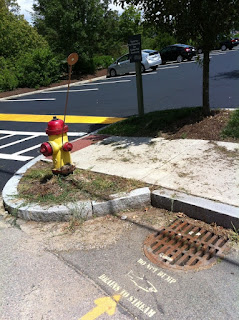Rating System Fails to Protect Users from Coal Tar Sealcoat
 Imagine the disappointment to learn that your awesome green building with eco-this and low-emitting-that just sealed their parking lot with what you have come to learn is highly toxic, coal tar pavement sealers. Now add to that you are a cancer survivor who is try to limit your exposure to chemicals; plus you don’t have the resources to find another place.
Imagine the disappointment to learn that your awesome green building with eco-this and low-emitting-that just sealed their parking lot with what you have come to learn is highly toxic, coal tar pavement sealers. Now add to that you are a cancer survivor who is try to limit your exposure to chemicals; plus you don’t have the resources to find another place.LEED is a good process through the design and construction of a project, but coal tar sealers are never used in the first 6 months to a year in a project. It has failed this resident and likely many more across the country. If LEED wants to protect its reputation, then it should require this to be remediated or revoke the LEED rating. There is a process for that, though never known to be used. A complaint has already been filed by the resident.
The evidence is strong enough that the use of coal tar sealers on ANY LEED project should be grounds for revoking its certification.
And now from the resident:
 |
| Green building with a coal tar sealed parking lot. At least the parking lot doesn’t allow smoking and has a Prius parking in it. |
When we are born we are given an empty glass, during the course of our life our glass is filled with the toxins our bodies collect from the air, the water and our food. When it becomes full we may start to see the effects take it’s toll on our bodies.
We trust our neighbors to use products that do not have an ill effect on others or themselves. We need to be informed to make wise decisions. We trust our government to regulate dangerous toxins, at the very least do not use them in public places such as schools, state parks, public beaches. Home Depot and Lowes pulled this product from their shelves. Why are we not all jumping on board? There are safer alternatives.
When a future development presents themselves to a community as being “Eco Friendly”, “LEED Certified” it instills a certain kind of trust in them. I moved into such a place with faith they would use safe products on site. I am a two time cancer survivor. When my “Gold LEED” certified building had our parking lots sealed last month I noticed a very strong odor. I shut my windows and began research. I found many sites concerning coal-tar-based products. I contacted the company who did the project. I was told it was “Tarconite”.
This product has been banned from the states of MN and WA, Washington DC banned it in 2009. Austin, TX has banned it and is removing it from the parking lots of all schools and playgrounds. This product has water soluble properties which in rainy weather may find it’s way down our storm drains into our drinking water, our streams, our lakes and wetlands. My drinking water comes from wells. We have a beautiful little lake near us with many wetland areas. We need to protect and preserve the beauty we have been blessed with.
We cannot for the health of our earth or those who exist on it continue to use toxic products. Move forward to a healthier existence for the future of all.
To A Brighter Future,
